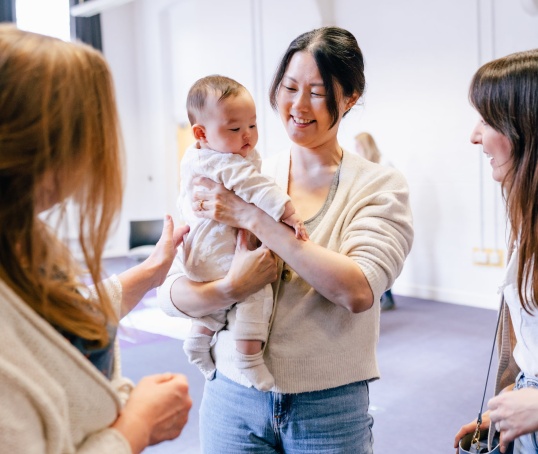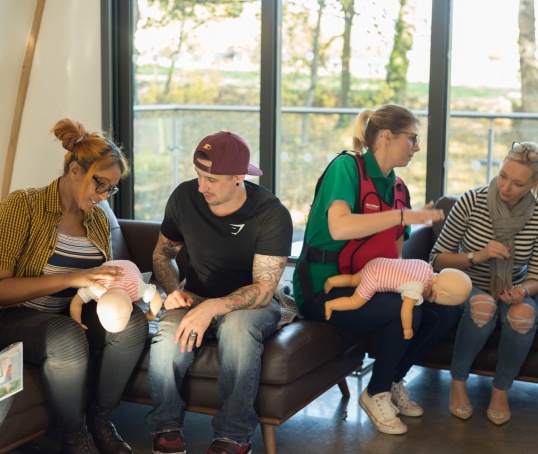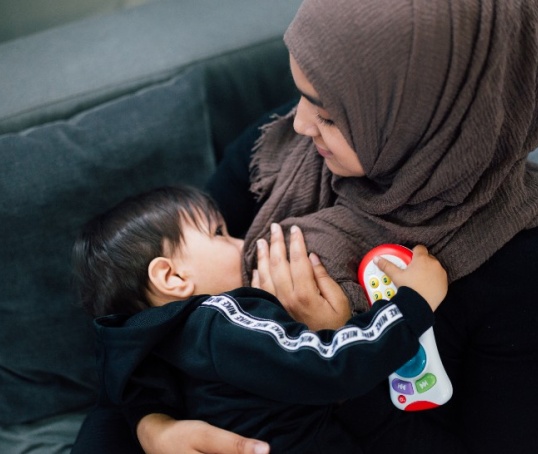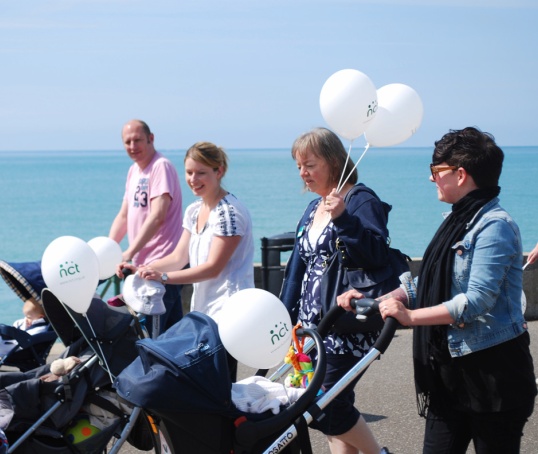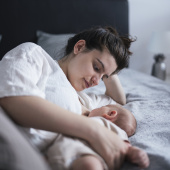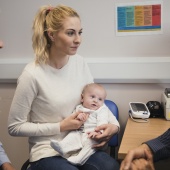There can be a lot of new and unexpected sensations in the body after giving birth. If concerned we suggest speaking to the midwife or GP, as they can usually be completely resolved.
The woman or birthing parent should be asked about their health every time they see a midwife or GP after birth (NICE, 2021). This is an opportunity to talk about any issues.
- Bleeding after birth
- Fatigue
- First wee/poo
- Leaking urine
- Leaking poo
- Constipation
- Mental health
- Pain
- Piles
- Stitches and scars
- Stomach
- Stretch marks
- Vulva and vagina
- Weight
Fatigue
Being pregnant and then giving birth is exhausting. Then there are the sleepless nights. So it’s no surprise that new parents are often very tired.
Many cultures have ‘lying in’ periods for recovery after birth, where family and friends pick up all the chores and feed the new parent nutritious foods.
To be in best shape to care for the new baby or babies, you need to prioritise rest. While some people have family and friends available locally to help, others do not. On our Antenatal courses we help create groups so you can share the joys, challenges, and tips.
If you're struggling to cope, the GP or health visitor should be able to help (NHS, 2022a).
Family Lives are a charity offering support and information.
Home Start offers parent helper visiting schemes.
First wee/poo after birth
Having the first wee or poo after giving birth can cause anxiety, especially if there’s tenderness, stitches or no feeling in the area. It’s very unlikely that stitches will open (NHS, 2024a).
Things that can help include:
- drinking water to dilute the urine and reduce stinging (NHS, 2024a)
- weeing in the shower or bath
- pouring water over the body while weeing
- holding a flannel or maternity pad over stitches while pooing (NHS, 2024a)
If you’re concerned keep a diary of how often you’re weeing and pooing and if it hurts, to discuss with the GP.
The Bladder and Bowel Community has information on keeping a bladder or bowel diary.
Leaking urine
Leaking urine is called urinary incontinence. There are different types of urinary incontinence, but the one that is most common during pregnancy and after birth is called stress incontinence.
What is stress incontinence?
Activities which put sudden extra pressure on the bladder, like sneezing, coughing, laughing or exercise can cause extra pressure on the bladder and cause wee to leak out. This is stress incontinence (NHS, 2023a; NHS, 2023b).
How common is it?
Recent research suggests that around half of women and pregnant people experience stress incontinence in pregnancy (Parlas & Bilgic, 2024). Two months after birth this has dropped to around 21 in 100, and at 12 months after birth it is down to 11 in 100 (Gmelig Meyling et al, 2023).
Causes
Stress incontinence is associated with:
- A weak pelvic floor (NHS, 2023a)
- A urinary tract infection (UTI) (NHS, 2023c)
- Pregnancy
- Assisted vaginal birth with forceps or ventouse
- An epidural, but bladder control should return within a few hours as it wears off (NHS, 2023d)
Treatment
Treatment can be highly effective in reducing stress incontinence.
After checking to rule out a UTI, the GP will suggest (NHS, 2023c):
- pelvic floor exercise to increase muscle strength
- bladder training
If non-surgical approaches don’t reduce the stress incontinence, surgical measures might be suggested (NHS, 2023c).
The Pelvic Obstetric and Gynaecological Physiotherapy Group have information on physiotherapy during pregnancy and after having a baby.
Leaking poo
Although less common than leaking urine, leaking poo, also known as faecal [fee-cal] incontinence, is very distressing for the mother or birthing person (Woodley et al, 2020).
At three months after giving birth for the first time (Woodley et al, 2020):
- up to 46 in 100 women or birthing people might be unable to control the passing of wind
- around 5 in 100 may not be able to control the passing of poo. This is most likely when there has been a third- or fourth-degree tear.
A GP will be able to suggest treatment.
Constipation
Constipation is commonly experienced during pregnancy, and sometimes after birth. Read our article on common discomforts during pregnancy.
To prevent constipation after birth, eat fresh fruit, vegetables, wholegrain cereals and bread, and drink lots of water. Talk to the GP or midwife if you have constipation that lasts for a while (NHS, 2024a).
Pain
It’s normal to feel discomfort even after the most straightforward birth. Paracetamol and Ibuprofen can both be used when breastfeeding (Breastfeeding Network, 2025).
If a headache isn’t responding to normal medication, check the symptoms of pre-eclampsia, which can still happen after birth.
Some people experience back pain, and the NHS has tips on back care after birth.
When to get emergency help
Pain in one leg, usually but not always after a caesarean, could be a sign of thrombosis.
Chest pain and difficulty breathing might be a sign of pulmonary embolism.
Both of these are serious conditions and need urgent contact with a health professional.
Stitches and scars
Read our articles on recovery from tearing or episiotomy, and recovery after birth, for more information about stitches and caesarean scars.
Stomach
What are afterpains?
Sometimes when the womb shrinks back to its normal size after birth, it can feel like period cramps. This is normal, and can be most noticeable when breastfeeding as this stimulates the womb to contract (NHS, 2022b).
What is stomach separation?
Diastastis recti [di-a-stay-sis rec-ti] is when the two muscles running down the middle of the stomach separate during pregnancy. This is common and happens because the growing womb pushes the muscles apart (NHS, 2023e).
After the baby is born, it usually goes back to normal after eight weeks or so. Contact the GP if it doesn’t feel like this has happened (NHS, 2023e).
Regularly doing pelvic floor and stomach exercises can help reduce the size of the separation (NHS, 2023e). See our article on pelvic floor and stomach muscle exercises.
Vulva and vagina after birth
It’s very common to feel that the vagina is looser, softer and more open than before birth. The whole vulval area – vagina and external tissues – can feel bruised and swollen.
Cool packs on the area, resting and pain relief can help. Bruising and soreness usually settles within a week.
If the discomfort is caused by a tear or stitches , take a look at our article on care and recovery after tearing or episiotomy.
What if the vagina feels dry?
The vagina might feel drier after birth, due to hormonal changes (NHS, 2024b). Our article on sex after having a baby explains more.
When will periods start again?
Everyone is different, but breastfeeding and expressing can delay periods starting. Periods might not start until breastfeeding is reduced (NHS, 2024a).
If formula feeding or mixed feeding, periods might start five or six weeks after the birth (NHS, 2024a).
Can tampons or menstrual cups be used after birth?
It’s best not to use tampons or menstrual cups until after the 6-8 week postnatal check. This is to avoid the risk of infection (NHS, 2024a).
Weight
The weight gained during pregnancy is gradually lost over the following months. Breastfeeding can help, as it uses calories (La Leche League GB, 2019).
The breastfeeding woman or parent may feel hungrier and thirstier. However, it is not necessary to ‘eat for two’ as the body uses the reserves stored during pregnancy and becomes efficient at converting food into milk. So, a small increase in healthy foods is all that is needed (La Leche League GB, 2019).
Our article on eating and drinking during pregnancy and while breastfeeding provides more guidance.
Gmelig Meyling MM, Frieling ME, Vervoort JPM, Feijen-de Jong EI, Jansen DEMC. (2023) Health problems experienced by women during the first year postpartum: A systematic review. Eur J Midwifery. Dec 18;7:42. https://doi.org/10.18332/ejm/173417
La Leche League GB (2019) Breastfeeding and a Mother’s Diet: Myths and Facts. https://laleche.org.uk/breastfeeding-and-a-mothers-diet-myths-and-facts/ [7 Aug 25]
NHS (2022a) Sleep and tiredness after having a baby. https://www.nhs.uk/baby/support-and-services/sleep-and-tiredness-after-… [7 Aug 25]
NHS (2022b) Early days. https://www.nhs.uk/pregnancy/labour-and-birth/after-the-birth/early-days [29 Jul 25]
NHS (2023a) Urinary incontinence: Causes. https://www.nhs.uk/conditions/urinary-incontinence/causes/ [29 Jul 25]
NHS (2023b) Urinary incontinence: Symptoms. https://www.nhs.uk/conditions/urinary-incontinence/symptoms/ [29 Jul 25]
NHS (2023c) Urinary incontinence: Overview https://www.nhs.uk/conditions/urinary-incontinence/ [29 Jul 25]
NHS (2023d) Epidural: Side effects. https://www.nhs.uk/tests-and-treatments/epidural/side-effects/ [29 Jul 25]
NHS (2023e) Your post-pregnancy body. https://www.nhs.uk/baby/support-and-services/your-post-pregnancy-body/ [6 Aug 25]
NHS (2024a) Your body after the birth. https://www.nhs.uk/pregnancy/labour-and-birth/after-the-birth/your-body/ [29 Jul 25]
NHS (2024b) Sex and contraception after birth. https://www.nhs.uk/baby/support-and-services/sex-and-contraception-afte… [29 Jul 25]
NICE (2021) Postnatal care [NG194]. https://www.nice.org.uk/guidance/ng194 [29 Jul 25]
Parlas M, Bilgic D. (2024) Awareness of urinary incontinence in pregnant women as a neglected issue: a cross-sectional study. Malawi Med J. Mar 20;36(1):53-63. https://doi.org/10.4314/mmj.v36i1.9
Woodley SJ, Lawrenson P, Boyle R, Cody JD, Mørkved S, Kernohan A, Hay-Smith EJC. (2020) Pelvic floor muscle training for preventing and treating urinary and faecal incontinence in antenatal and postnatal women. Cochrane Database Syst Rev. May 6;5(5):CD007471. https://doi.org/10.1002/14651858.CD007471.pub4


